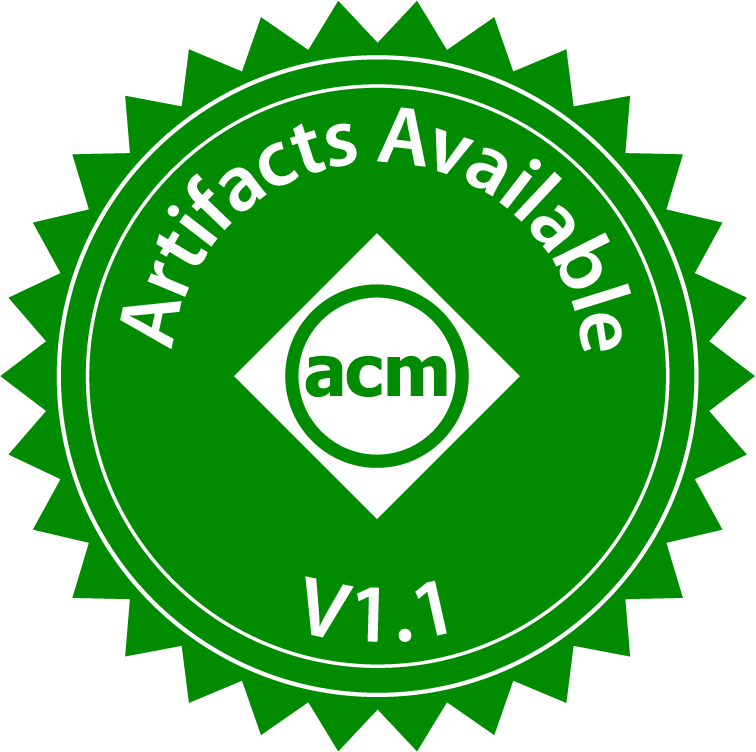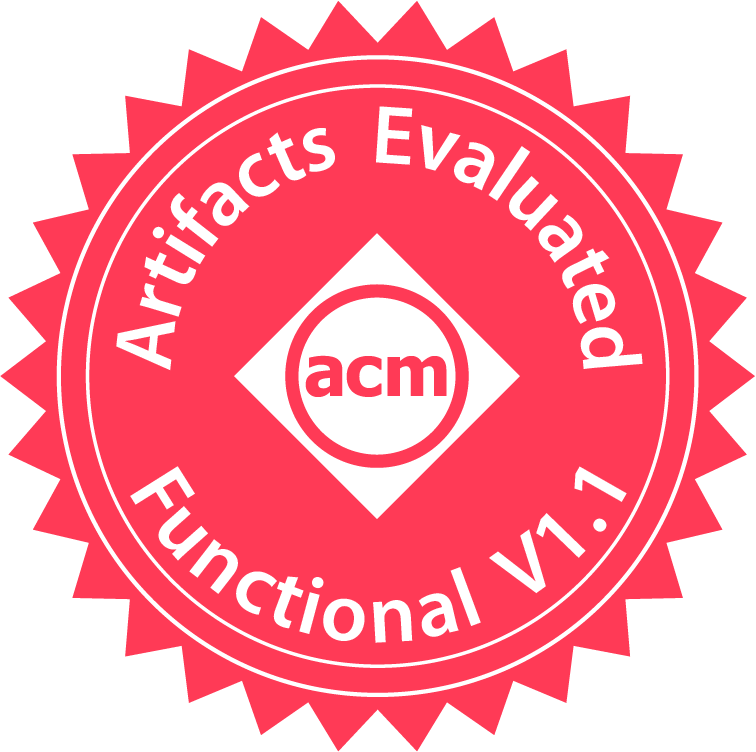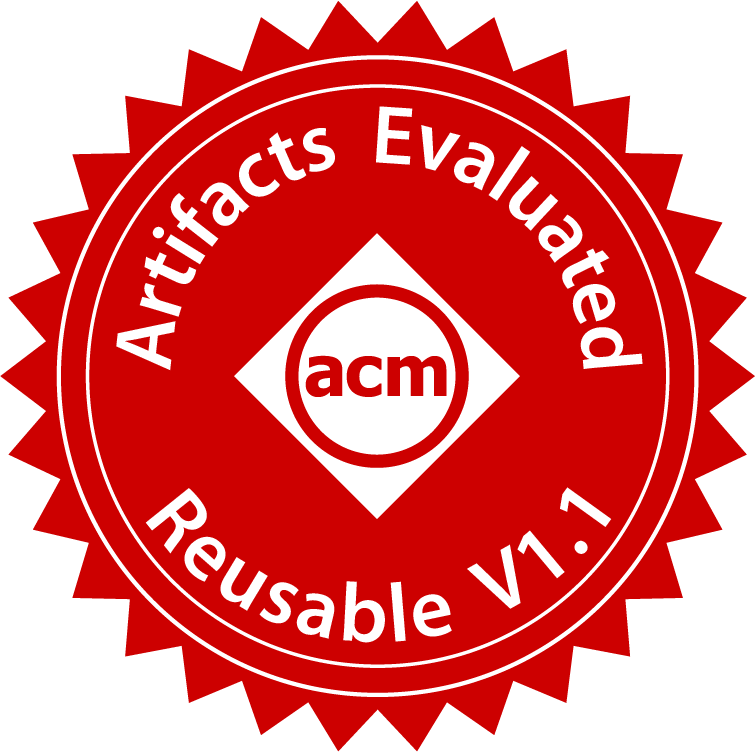
Co-located with NDSS'22 @ San Diego, California
| Home | Program | Dates | FAQ | Program Committee |
The two main goals of the artifact evaluation are:
All submissions should aim to get all three available badges (available, functional, reusable) to ensure the reproducibility of their research.
Since the accepted full papers in Fuzzing'2022 will be published in TOSEM, we have the option to assign the official ACM badges for Available, Functional, and Reusable (https://www.acm.org/publications/policies/artifact-review-and-badging-current).

Author-created artifacts relevant to this paper have been placed on a publicly accessible archival repository. A DOI or link to this repository along with a unique identifier for the object is provided.

The artifacts associated with the research are found to be documented, consistent, complete, exercisable, and include appropriate evidence of verification and validation.

Functional + The artifacts associated with the paper are of a quality that significantly exceeds minimal functionality. That is, they have all the qualities of the Artifacts Evaluated - Functional level, but, in addition, they are very carefully documented and well-structured to the extent that reuse and repurposing is facilitated. In particular, norms and standards of the research community for artifacts of this type are strictly adhered to.
| Phase/Milestone | Date (in AoE) |
|---|---|
| Full journal paper submission (incl. experiments and artifact) | 1 September 2022 |
| (Phase 1) Test phase (installation, instructions, etc.) | 5-9 September 2022 |
| Deadline for clarifications by the authors | 12 September 2022 |
| (Phase 2) First evaluation round | 13-27 September |
| Deadline for author response and artifact improvements | 2 October 2022 |
| (Phase 3) Second evaluation round (if needed) | 3-10 October |
This artifact evaluation is performed in three phases:
(Phase 1) Test phase:
The Artifact Evaluation Committee (AEC) may contact the authors within the Test Phase to request clarifications on the basic installation and start-up procedures or to resolve simple installation problems. Given the short review time available, the authors are expected to respond within a 48-hour period but no later than September 12, 2022. Authors may update their research artifact after submission only for changes requested by reviewers and only until September 12, 2022. The authors submitting an open-source repository link are expected to give a tag to time-stamp your submission.
(Phase 2) First evaluation round: After the test phase, the AEC will conduct the full artifact evaluation and submit reviews and badge recommendations for each artifact. Afterwards, there will be the possibility for the authors to revise their artifacts and improve them according to the reviewer's feedback. The author response and artifact improvement deadline is October 2, 2022.
(Phase 3) Second evaluation round (if needed): If the AEC requested changes with their Phase 2 feedback, the AEC would conduct another round of reviews for the improved artifacts. Afterwards, the decision on the artifact badges will be finalized.
Note that HotCRP will serve as the main communication medium between authors and reviewers. The authors are expected to respond timely to the reviewer's questions, in particular, during Phase 1.
The short paper, i.e., the RCR report, should be titled: "[Paper Title] - RCR Report" where "[Paper Title]" is the title of the submitted TOSEM paper. RCR Reports shall use ACM journal format of short papers, and preferably comply with the following suggested structure:
Authors must perform the following steps to submit an artifact:
The configuration and installation of the artifact should take less than 30 minutes. Otherwise, the artifact is unlikely to be endorsed.
The artifact shall include an installation package so the tool can be installed and run in commonly available environments. Provide enough associated instruction, code, and data such that some CS person with a reasonable knowledge of scripting, build tools, etc., could install, build, and run the code. If the artifact contains or requires a special tool or any other non-trivial piece of software, the authors shall provide a VirtualBox VM image or a Docker container image with a working environment containing the artifact and all the necessary tools.
We expect the artifacts to be vetted on a clean machine before submission.
The authors shall make the packaged artifact available so that the readers of the RCR report can access it. The digital artifact should be available on a long-term archival platform that comply with the FAIR principles (findable, accessible, interoperable, reusable, more details can be found here https://www.nature.com/sdata/policies/repositories#general). We strongly recommend either https://www.figshare.com or https://www.zenodo.org.
The package shall include a documentation explaining how to (i) obtain the artifact package, (ii) unpack the artifact, (iii) get started, and (iv) use the artifacts. The artifact submission shall only describe the technicalities of the artifacts and uses of the artifact that are not already described in the RCR report and associated paper.
The submission should contain the following documents (in plain text or pdf format) in a zip archive:
By September 1, 2022, submit your research artifact at the Manuscript Central TOSEM website (choosing the RCR paper type) and by uploading the abstract describing your artifact. The abstract should include the DOI for your artifact, the paper title, the purpose of the research artifact, the badge(s) you are claiming, and the technology skills assumed by the reviewer evaluating the artifact. Please also mention if running your artifact requires specific Operation Systems or other environments.
After submitting your artifact to TOSEM, please also upload the same artifact to our HotCRP instance: https://fuzzing22-ae.hotcrp.com.
For AEC members, we are currently creating custom reviewing guidelines, which will be based on the ESEC/FSE'2021 for the AE guidelines: https://2021.esec-fse.org/getImage/orig/fse_artifacts_submission_reviewing_guidelines.pdf.
If you need more input on how to produce a high-quality artifact, please check out the following additional resources:
In case of any questions, please do not hesitate to contact us!
| Design by Mike Pierce | © Conference Organizers |